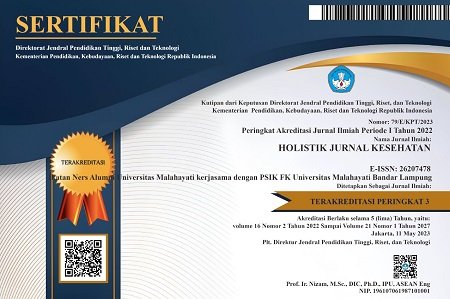Light‐emitting diode phototherapy for neonatal hyperbilirubinemia: A literature review
Abstract
Background: Neonatal hyperbilirubinemia is a problem that often occurs in newborns who must be separated between mother and baby due to phototherapy. Clinically, jaundice or symptoms of changes in the sclera, mucous membranes and skin becoming yellow can be seen if there is an increase in the bilirubin concentration of more than 5 mg/dl. In most infants, the development of unconjugated hyperbilirubinemia is a normal transition. However, in some babies plasma levels can increase excessively, this can be a concern because bilirubin is not conjugated so it is neurotoxic and can cross the blood brain barrier, causing brain damage.
Purpose: To provide an overview of the results of a literature review regarding the effectiveness of light emitting diode (LED) phototherapy in reducing total serum bilirubin (TSB) levels.
Method: The literature review study used the preferred reporting items for systematic reviews and meta-analyses (PRISMA) to conduct systematic observations, a prospective comparative study, a randomized controlled trial, a retrospective chart review, and two prospective studies. Based on article searches, 1.270 articles were successfully extracted, resulting in 12 full text articles that were relevant to the topic of discussion.
Results: Various research results show that LED lights have better effectiveness in reducing TSB levels. All phototherapy methods are effective in reducing TB within safe limits. Mounting evidence suggests that dual LED phototherapy is effective for the management of hyperbilirubinemia in neonates.
Conclusion: Phototherapy using LED lights in the form of bags or blankets is more effective in reducing bilirubin levels more quickly compared to compact fluorescent lights or conventional phototherapy.
Keywords: Hyperbilirubin; Newborn; Phototherapy Light Emitting Diodes.
Pendahuluan: Hiperbilirubinemia neonatal merupakan masalah yang sering terjadi pada bayi yang baru lahir, yang terpaksa memisahkan ibu dan bayi karena dilakukan fototerapi. Secara klinis, ikterik atau suatu gejala perubahan sklera, membran mukosa, dan kulit menjadi kuning dapat dilihat ketika terjadi kenaikan konsentrasi bilirubin lebih dari 5 mg/dl. Pada sebagian besar bayi, kejadian hiperbilirubinemia tidak terkonjugasi merupakan transisi normal. Namun, pada beberapa bayi kadar plasma mungkin meningkat berlebihan, hal ini dapat menjadi perhatian karena bilirubin tidak terkonjugasi sehingga bersifat neurotoksik dan dapat melewati sawar darah ke otak yang menyebabkan kerusakan otak.
Tujuan: Untuk memberikan gambaran dari hasil review literatur tentang efektifitas fototerapi light emitting diode (LED) dalam mengurangi kadar total serum bilirubin (TSB).
Metode: Penelitian literature review menggunakan preferred reporting items for systematic reviews and meta-analysis (PRISMA) untuk melakukan tinjauan sistematis, prospective comparative study, randomized controlled trial, retrospective chart review, dan two prospective study. Berdasarkan pencarian artikel didapatkan sebanyak 1.270 artikel yang diekstraksi hingga mendapatkan 12 artikel full text yang relevan dengan topik pembahasan.
Hasil: Berbagai hasil penelitian menunjukkan sinar LED memiliki efektivitas lebih baik untuk menurunkan kadar TSB. Semua metode fototerapi efektif menurunkan TSB dalam batas aman. Banyak bukti menunjukkan bahwa fototerapi LED ganda adalah efektif untuk penatalaksanaan hyperbilirubinemia pada neonates.
Simpulan: Fototerapi yang menggunakan sinar LED dan berbentuk kantong atau selimut lebih efektif lebih cepat dalam menurunkan kadar bilirubin dibandingkan dengan fototerapi compact fluorescent light atau konvensional.
Kata Kunci : Bayi Baru Lahir; Fototerapi Light Emitting Diode; Hiperbilirubin.
Keywords
References
Abrams, M., Gosselin, K., Roth, C. K., & Hoffman, N. (2023). A Randomized Trial Comparing NeoLight Skylife and Blanket Phototherapy in Newborn Indirect Hyperbilirubinemia. Clinical Pediatrics, 00099228231190120.
Borden, A. R., Satrom, K. M., Wratkowski, P., George, T. N., Adkisson, C. A., Vreman, H. J., ... & Slusher, T. M. (2018). Variation in the phototherapy practices and irradiance of devices in a major metropolitan area. Neonatology, 113(3), 269-274.
Donneborg, M. L., Vandborg, P. K., Hansen, B. M., Rodrigo-Domingo, M., & Ebbesen, F. (2018). Double versus single intensive phototherapy with LEDs in treatment of neonatal hyperbilirubinemia. Journal of Perinatology, 38(2), 154-158.
Ebbesen, F., Vreman, H. J., & Hansen, T. W. R. (2022). Blue-Green (~ 480 nm) versus Blue (~ 460 nm) Light for Newborn Phototherapy—Safety Considerations. International Journal of Molecular Sciences, 24(1), 461.
Faiqah, S. (2018). Hubungan Usia Gestasi dan Jenis Persalinan Dengan Kadar Bilirubinemia Pada Bayi Ikterus di RSUP NTB. Jurnal Kesehatan Prima, 8(2), 1355-1362.
Gutta, S., Shenoy, J., Kamath, S. P., Mithra, P., Baliga, B. S., Sarpangala, M., & Srinivasan, M. (2019). Light emitting diode (LED) phototherapy versus conventional phototherapy in neonatal hyperbilirubinemia: a single blinded randomized control trial from coastal India. BioMed Research International, 2019.
Joel, H. N., Mchaile, D. N., Philemon, R. N., Mbwasi, R. M., & Msuya, L. (2021). Effectiveness of FIBEROPTIC phototherapy compared to conventional phototherapy in treating HYPERBILIRUBINEMIA amongst term neonates: a randomized controlled trial. BMC pediatrics, 21(1), 1-9.
Kementerian Kesehatan Republik Indonesia. (2019). Peraturan Menteri Kesehatan Republik Indonesia Nomor 240 tentang Pedoman Nasional Pelayanan Kedokteran Tata Laksana Hiperbilirubinemia. Diakses dari: https://yankes.kemkes.go.id/unduhan/fileunduhan_1610349726_94555.pdf
Khunte, M., Panigrahi, D., & Kosam, A., (2019) Comparative Study Between CFL and LED Phototherapy Devices for Unconjugated Hyperbilirubinemia in Neonates. Pediatric Rev: int j pediatrics res 2019, 6, 70-75. Diakses dari: https://pediatrics.medresearch.in/index.php/ijpr/article/view/465
Lovera, L. A., Torres, J., & García-Perdomo, H. A. (2023). Effectiveness and safety of prophylactic phototherapy to prevent jaundice in premature newborns: Systematic review and meta-analysis. Journal of Child Health Care, 13674935231187716.
Luciano, R., Mancini, G., Cota, F., Romano, A., Purcaro, V., Lerro, F., & Vento, G. (2019). New high intensity fibreoptic phototherapy devices in healthy newborns: a single pad wrapped around the neonate body in comparison with a double pad device. Italian journal of pediatrics, 45(1), 1-5.
Maisels, M. J., Clune, S., Coleman, K., Gendelman, B., Kendall, A., McManus, S., & Smyth, M. (2014). The natural history of jaundice in predominantly breastfed infants. Pediatrics, 134(2), e340-e345.
Menaldi, S. L. S. W. (2019). Pedoman Nasional Pelayanan Kedokteran Tata Laksana Kusta
Montealegre, A., Charpak, N., Parra, A., Devia, C., Coca, I., & Bertolotto, A. M. (2020). Efectividad y seguridad de 2 dispositivos de fototerapia para el manejo humanizado de la ictericia. In Anales de pediatria (Vol. 92, No. 2, pp. 79-87). Elsevier Doyma.
Pace, E. J., Brown, C. M., & DeGeorge, K. C. (2019). Neonatal hyperbilirubinemia: an evidence-based approach. J Fam Pract, 68(1), E4-E11.
Purkait, R., & Mondal, M. (2020). Effectiveness of light emitting diode versus conventional phototherapy in neonatal hyperbilirubinemia: a hospital based observational study.
Rehman, K., Subhani, F. A., Shah, S. A., Ahmed, B., Ayub, A., & Sheikh, S. A. (2023). Comparison of Effects of LED Phototherapy with Compact Fluorescent Phototherapy in Neonates with Hyperbilirubinemia. Pakistan Armed Forces Medical Journal, 73(3), 739.
Rohsiswatmo, R., & Amandito, R. (2018). Hiperbilirubinemia pada neonatus> 35 minggu di Indonesia; pemeriksaan dan tatalaksana terkini. Sari Pediatri, 20(2), 115-122.
Safitri, Z. N. (2017). Perancangan pusat kesehatan kulit dengan pendekatan arsitektur biofilik di Kota Malang (Doctoral dissertation, Universitas Islam Negeri Maulana Malik Ibrahim).
Saleem, A., Ahmed, B., Shah, S. A., Subhani, F. A., Ayub, A., & Shiekh, S. A. (2023). Comparison of Effects of LED Phototherapy with Compact Fluorescent Phototherapy in Neonates with Hyperbilirubinemia. Pakistan Armed Forces Medical Journal, 73(2), 337-40.
Sari, A. E., & Subiastutik, E. (2021). Faktor yang Berhubungan dengan Kejadian Ikterus Neonatorum di RS Permata Bunda Malang. Ovary Midwifery Journal, 3(1), 31-43.
Widyaningsih, H., Nugrahani, F., & Indriyati, I. (2015). Hubungan Faktor Risiko Infeksi Neonatus Dengan Kejadian Leukositosis Pada Neonatus di Rumah Sakit Umum Dokter Soehadi Prijonegoro Sragen (Doctoral dissertation, Universitas Sahid Surakarta).
Wiegert, S., & Mai, H. (2022). Effectiveness of Dual-Blanket Phototherapy Compared With Combination Phototherapy on Rate of Bilirubin Decline and Treatment Duration. Journal of Pediatric Health Care, 36(3), 240-247.
DOI: https://doi.org/10.33024/hjk.v17i9.13064
Refbacks
- There are currently no refbacks.
Copyright (c) 2024 Holistik Jurnal Kesehatan

This work is licensed under a Creative Commons Attribution-NonCommercial 4.0 International License.














